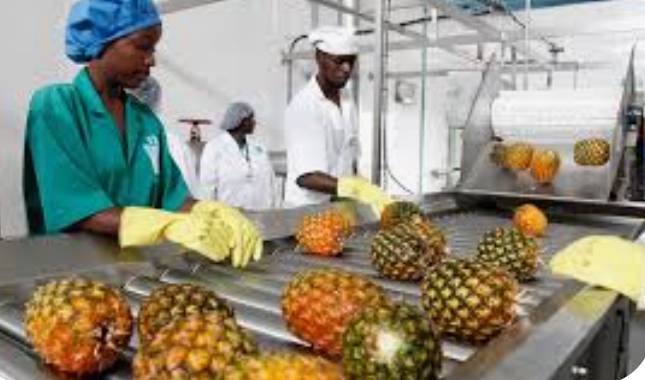[10/23, 16:12] Meta AI: Food Processing
*Definition:* Food processing is the transformation of raw ingredients into consumable food products through various methods, including cleaning, sorting, packaging, and preservation.
*Types of Food Processing:*
1. Primary Processing: Cleaning, sorting, grading, and packaging raw materials.
2. Secondary Processing: Transforming primary products into intermediate or final products (e.g., canning, freezing).
3. Tertiary Processing: Manufacturing ready-to-eat products (e.g., baked goods, snacks).
*Methods of Food Processing:*
1. Thermal Processing (Heat): Cooking, pasteurization, sterilization.
2. Non-Thermal Processing (No Heat): Irradiation, high-pressure processing, pulsed electric field.
3. Mechanical Processing: Grinding, mixing, emulsification.
4. Chemical Processing: Preservation, fermentation, acidification.
5. Biological Processing: Fermentation, enzymatic processing.
*Food Processing Techniques:*
1. Canning
2. Freezing
3. Dehydration
4. Fermentation
5. Smoking
6. Pickling
7. Emulsification
8. Homogenization
9. Pasteurization
10. Sterilization
*Benefits of Food Processing:*
1. Extended Shelf Life
2. Improved Food Safety
3. Enhanced Nutritional Value
4. Increased Convenience
5. Reduced Food Waste
6. Economic Benefits (job creation, increased trade)
*Challenges in Food Processing:*
1. Food Safety and Quality Control
2. Energy Consumption and Environmental Impact
3. Water Usage and Conservation
4. Food Waste Reduction
5. Maintaining Nutritional Value
6. Meeting Consumer Demands (taste, texture, convenience)
*Food Processing Industries:*
1. Meat and Poultry Processing
2. Dairy Processing
3. Fruits and Vegetables Processing
4. Grain Processing
5. Bakery and Confectionery
6. Beverages (juices, soft drinks, beer)
*Food Processing Equipment:*
1. Ovens
2. Mixers
3. Grinders
4. Centrifuges
5. Evaporators
6. Dryers
7. Fillers and Sealers
8. Packaging Machinery
*Food Processing Regulations:*
1. FDA (Food and Drug Administration)
2. USDA (United States Department of Agriculture)
3. HACCP (Hazard Analysis and Critical Control Points)
4. GMP (Good Manufacturing Practices)
5. ISO 22000 (Food Safety Management System
: The benefits of food processing include:
*Physical Benefits:*
1. Extended Shelf Life: Food processing techniques like canning, freezing, and dehydration extend shelf life.
2. Convenience: Processed foods are often pre-cooked, pre-cut, or pre-packaged for easy consumption.
3. Improved Texture and Appearance: Processing can enhance texture, color, and overall appeal.
*Nutritional Benefits:*
1. Preservation of Nutrients: Processing helps retain nutrients that might be lost during storage or transportation.
2. Fortification: Processed foods can be enriched with essential vitamins and minerals.
3. Reduced Food Waste: Processing reduces waste by utilizing entire raw materials.
*Safety Benefits:*
1. Reduced Risk of Foodborne Illnesses: Processing techniques like pasteurization and sterilization eliminate pathogens.
2. Improved Hygiene: Processing facilities maintain strict sanitation standards.
3. Detection and Removal of Contaminants: Processing allows for detection and removal of contaminants.
*Economic Benefits:*
1. Job Creation: Food processing creates employment opportunities.
2. Increased Trade: Processed foods can be exported, boosting local economies.
3. Reduced Transportation Costs: Processed foods are lighter and easier to transport.
*Social Benefits:*
1. Food Accessibility: Processed foods reach remote or underserved areas.
2. Cultural Exchange: Processed foods introduce new cuisines and flavors.
3. Emergency Food Supply: Processed foods provide essential nutrition during natural disasters or conflicts.
*Environmental Benefits:*
1. Reduced Food Waste: Processing reduces waste by utilizing entire raw materials.
2. Water Conservation: Processing techniques like dehydration conserve water.
3. Energy Efficiency: Modern processing technologies optimize energy usage.
*Other Benefits:*
1. Increased Food Variety: Processing creates diverse food products.
2. Improved Food Consistency: Processing ensures consistent taste, texture, and quality.
3. Reduced Seasonal Dependence: Processing makes seasonal foods available year-round.
Overall, food processing plays a vital role in ensuring food safety, availability, and accessibility while supporting economic growth and social well-being.
: Here are some of the most common food processing methods:
*Thermal Processing Methods:*
1. Cooking: Boiling, steaming, roasting, grilling, frying.
2. Pasteurization: Heat treatment to kill pathogens (e.g., milk, juice).
3. Sterilization: High-temperature processing to eliminate microorganisms (e.g., canned goods).
4. Canning: Heat processing to create vacuum-sealed containers.
5. Retorting: High-pressure steam processing for sterilization.
*Non-Thermal Processing Methods:*
1. Dehydration: Removal of water content (e.g., drying, freeze-drying).
2. Freezing: Preservation through low temperatures.
3. Irradiation: Ionizing radiation to kill pathogens.
4. High-Pressure Processing (HPP): Inactivates microorganisms without heat.
5. Pulsed Electric Field (PEF) Processing: Electromagnetic pulses to inactivate microorganisms.
*Mechanical Processing Methods:*
1. Grinding: Reducing particle size (e.g., flour, meat).
2. Mixing: Combining ingredients.
3. Emulsification: Blending oil and water-based ingredients.
4. Homogenization: Uniform distribution of fat molecules (e.g., milk).
5. Filtration: Separation of liquids and solids.
*Chemical Processing Methods:*
1. Preservation: Adding chemicals to prevent spoilage (e.g., sodium benzoate).
2. Fermentation: Microbial conversion of sugars into acids or gases.
3. Acidification: Lowering pH to inhibit microbial growth.
4. Smoking: Adding smoke flavor and preservatives.
*Biological Processing Methods:*
1. Fermentation: Microbial conversion of sugars into acids or gases.
2. Enzymatic Processing: Using enzymes to break down or modify ingredients.
3. Probiotics: Adding beneficial microorganisms.
*Other Processing Methods:*
1. Packaging: Aseptic packaging, vacuum packaging.
2. Modified Atmosphere Packaging (MAP): Controlling gas composition.
3. Ultraviolet (UV) Light Processing: Disinfecting surfaces.
These methods are used alone or in combination to produce a wide range of food products.


